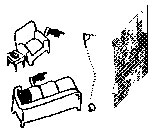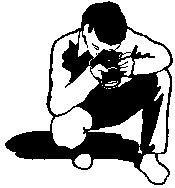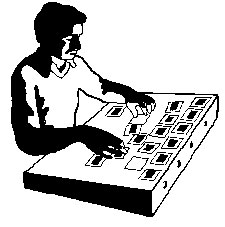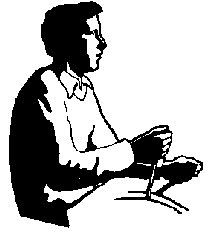
Points
on the Collage Path:
Fragmentation
Fragmentation — Get a box >


Collage House
“Everything had broken down and new things had to be made out of the fragments.”
— Kurt Schwitters
Fragmentation
The mind is, inherently, a pluralistic society; a collage is, above all, a contained multiplicity. Hence it is not the action of isolated images, no matter how potent, that motivates the movement we will follow here; it is, rather, energies and tensions generated within multi-image fields that propel it.
Accordingly, the cultural background presumed by the Collage Path is the contemporary experience of over-stimulation and fragmentation: the experience of multiple elements proliferating, generating a surplus of feeling, becoming unmanageable.Psychotherapy generally assumes that the patient’s ego must be exposed gradually and cautiously to the experience of divergent impulses and ideas, and, accordingly, the psychotherapeutic process begins with the notion of a presumed (even if defensive) unity.
The Collage Method works differently. The individual-developmental background presumed by the Collage Method is the infant’s experience of incohesion—the lack of a unified image of its own body or the surrounding world prior to the integration of the perceptual field: the body-in-pieces; the world a flicker of unstabilized appearances and vanishings. In this sense the Collage Path begins at the beginning. Fragmentation is the hallmark of the modern age, but it is also the point at which the human impulse toward form arises.
Read exchange with digital collage artist Dirk Hine on collage and depression.
“The
novelist Donald Barthelme’s statement that ‘Fragments are the
only form I trust’ has ramifications far beyond the literary. However
severe the problems posed by such a principle for social and especially
political revolution, we deceive ourselves unless we learn to focus upon
these shifting forms—to recognize new styles of life and new relations
to institutions and to ideas. Indeed, we require a little revolutionizing
of our psychological assumptions, so that both the young and the old can
be understood, not as bound by static behavioral categories, but as in
continuous historical motion.”
“The essence of the protean self lies in its odd combinations. There is a linking—often loose but functional—of identity elements and subselves not ordinarily associated with one another to the point of even seeming (in Max Ernst’s words) ‘mutually incompatible.’…The process is laid bare in James Joyce’s rendition of Ulysses, surely the great protean literary journey of the twentieth century. Joyce’s ‘Proteus’ episode (his titles and structure follow Homer’s) portrays ‘a world dominated by metamorphoses which continuously produce new centers of relations.’
“As
in the case of Joyce’s protagonist, Stephen Dedalus, the protean
self is always confronted with the danger that these odd combinations
will not cohere. But it continually combines its fragments in order to
avoid fragmentation. One could say the same for much of modern and contemporary
art, especially the cubist-collage tradition, as I shall also suggest…”
— Robert Jay Lifton
History and Human Survival: Essays on the Young and the Old, Survivors
and the Dead, Peace and War, and on Contemporary Psychohistory, 1970
The Protean Self: Human Resilience in an Age of Fragmentation,
1993
“I notice you’d been
using words like ‘montage’ lately. You want to be careful; those
who live by montage perish by montage.”
— Kenneth Tynan
Letter to Dwight Macdonald, published in
“Between the Acts,” The New Yorker, October 31, 1994,
p. 84
“Our only health
is the disease
If we obey the dying nurse
Whose constant care is not to please
But to remind of our, and Adam’s curse,
And that, to be restored, our sickness
must grow worse.”
— T.S. Eliot
“East Coker,” 1940, Four Quartets
“The ego is first and foremost
a bodily ego; it is not merely a surface entity, but is itself the projection
of a surface.”
— Sigmund Freud
The Ego and the Id, 1923
“For Lacan, the ego is
a product of the internalization of otherness. It is also a psychical
projection of the body, a kind of map of the body’s psycho-social
meaning. Lacan’s account of the founding role of what he calls ‘the
imaginary anatomy’ is perhaps one of the most productive and under-developed
features of his work. The body as it is perceived or experienced by the
child is the fragmented or body-in-bits-and-pieces. This is an uncoordinated,
discrete assemblage of parts, exhibiting no regulated organization or
internal cohesion.”
— Elisabeth Grosz
Jacques Lacan: A Feminist Introduction, 1990
“The whole thing was so momentous, overmastering, tragic, that in
the end what I wanted to do was lie down and go to sleep. I have always
had an exceptional gift for passing out.… There are times when the
most practical thing is to lie down."
— Saul Bellow
Spoken by the character Charles Citrine in Humboldt’s Gift, 1975
“…the [modern] distress
lies exactly in formlessness; a sense of disconnection, or dissociation,
of feeling from activity — the extreme form of which may produce
schizophrenic language, but the routein form of which creates a sense
of meaninglessness in the midst of activity. The experience of emptiness,
of inability to feel, is not easily encompassed by mechanical notions
of repression. This shift in ordinary symptomatology has challanged psychoanalytic
thinking to find a new diagnostic language, and to expand terms which
in the early years of psychoanalysis were poorly thought out, because
the then dominant clinical experiences of distress did not demand their
articulation.”
— Richard Sennett
The Fall of Public Man, 1976
“I know my childhood was
one-of-a-kind, not at all for its fecklessness—on this restless,
errant continent I set no records—but for its lack of coherence.
I was a rat in the maze, getting shocked, getting sweets, dark/light,
cold/hot, prodded/cuddled, making my way to some eventual light, but no
one was taking notes. The researcher had fallen asleep. My life has been
pointless, one long search for meaning, which in a life means identity.
Sometimes I feel the technicians had forgotten to exterminate me when
the experiment was over; I was released back to the general rat population
and allowed to contaminate as many people as I could. Whatever lesson
my life might impart to others, unless I write about it and can do justice
to it, has been lost. Whatever I might have learned is still locked away.
I haven’t strayed from the shape and contents of my life because
I’m still trying to discover what I left behind.”
— Clark Blaise
I Had a Father: A Post-Modern Autobiography, 1993
“Be yourselves.”
—Lee Konitz
alto sax player
“Indefiniteness, proliferation, repetition, become less threatening
if they are concentrated into a threatening adversary or powerful force,
such as the castrating father; for this concentration makes possible a
specular confrontation which, even though it bring terror or defeat, confirms
the status of the self that repetition and proliferation threatened. ‘The
goal in each case,’ [Neil] Hertz writes, ‘is the oedipal moment
.… when an indefinite and disarrayed sequence is resolved (at whatever
sacrifice) into a one-to-one confrontation, when numerical excess is converted
into that supererogatory identification with the blocking agent that is
the guarantor of the self’s integrity as an agent.… A passage
to the limit may seem lurid, but it has its ethical and metaphysical uses.’
The demonic or the oedipal—the coloring of castration, for example—can
in fact be reassuring through its focusing and domesticating (bringing
back to the father) of repetition that otherwise might seem indefinite,
rhetorical, uncanny, gratuitous.”
— Jonathan Culler
On Deconstruction: Theory and Criticism after Structuralism, 1982,
pp. 266 -67
“The myth of
Isis and Osiris, as retold by Plutarch, presents such a concise scenario
that the most striking aspect of psychoanalytic discourse can be deduced
directly from it. We know the myth, which can be summarized briefly here.
The god Osiris is killed by Typhon who dismembers his corpse into pieces
which he then scatters in all directions. Osiris’s faithful companion,
Isis, patiently retrieves the fourteen pieces to reassemble and reanimate
them. However, there is one part of Osiris’s body which she cannot
find: his virile member. To replace this missing piece which is irretrievably
lost, Isis erects a simulacrum which she orders everyone to honor. The
myth thus presents itself as the justification of a rite: the exhibition
of the phallus, which has become the object of a cult in temples and which
is carried in procession during certain festivals. To quote Plutarch:
‘Of the parts of Osiris’s body the only one which Isis did not
find was the male member … but Isis made a replica (mimema) of the
member to take its place, and consecrated the phallus, in honor of which
the Egyptians even at the present day celebrate a festival.’”
—Jean-Joseph Goux
“The Phallus: Masculine Identity and the ‘Exchange of Women,’
1992 (Differences: The Phallus Issue, Spring 1992)
“Anything
one can advance along these lines, in whatever form, will merely accentuate
the signifying function that conditions paternity… Of course, there
is no need of a signifier to be a father, any more than to be dead, but
without a signifier, no one would ever know anything about either state
of being…
Indeed, in the subjective economy, governed as we see it by the unconscious,
it is a signification that is evoked only by what we call a metaphor,
in particular, the paternal metaphor.”
— Jacques Lacan
“On a Question Prelilminary to Any Possible Treatment of Psychosis,”
Écrits, 1966/77
“One could, therefore,
say that the human being is an effect of the signifier rather than its
cause. Insertion into the symbolic world is a mimesis, a collage. It fashions
a being of ‘representation’ for us.”
— Anika Lemaire
Jacques Lacan, 1970 / 77
“
…if …instead of beginning with the conscious, that is, by being
confronted by the adult in whom consciousness and cognition are fully
developed, and whom one looks backwards to the unconscious, we start with
the infant in whom cognitive faculties are not yet developed, and look
forward to cognition, then the reverse of the (usual) picture arises.
The strange part of the mind, the phantasy part is what confronts us.
This is now the norm, and the problem before us is: How and why does the
cognitive system arise?”
—Margaret
Lowenfeld
The World Technique, 1979
“As
you say that, all these things come back. My father worked with Heimie
a long time. Heimie was killed; he fell off a building. And my father
fell off a building, but later. They used to do their work on high buildings,
and they must have thought they were angels — or feathers. Among
other things my father broke was his pelvis, in five places. We were all
very proud of it, because no one we knew had a father with a pelvis broken
in five places.”
— Professor Weismann
“Discussion” in D. Weismann “The Collage as Model,”
1969
“‘And it was the murder of your father that decided you to come
here for treatment?’
‘Doesn’t it seem enough?’
‘The death of his father is always a critical moment in a man’s
life, but usually he has time to make psychological preparation for it.
The father grows old, relinquishes his claims on life, is manifestly preparing
for death. A violent death is certainly a severe shock. But then, you
knew your father must die sometime, didn’t you?’”
— Robertson Davies
The Deptfort Trilogy, 2, The Manticore, 1972, p. 282
“What has actually disappeared—in Sartre and in protean man
in general—is the classical superego, the interalization of clearly
defined criteria of right and wrong transmitted within a particular culture
by parents to their children. Protean man requires freedom from precisely
that kind of superego—he requires a symbolic fatherlessness —
in order to carry out his explorations. But we shall see that, rather
than being free of guilt, his guilt takes on a different form from that
of his predecessors.…He is starved for ideas and feelings that can
give coherence to his world, but here too his taste is toward new
combinations.”
— Robert Jay Lifton
“Protean Man,” 1968
“‘I didn’t
have a happy childhood,’ [Stemple] says. ‘My father died when
I was seven and a half, and I had a poor relation with my mother. By 1956,
I had spent eight years in the Army to get away from her.’”
— Herbert Stempel
Quoted in “Quiz Man,” on the 1959 scandal involving the quiz
show “Twenty-One,” The New Yorker, June 21, 1993, p.
33.
“Now that Sachs
is dead, I find it unbearable to think back to what he was like then,
to remember all the generosity and humor and intelligence that poured
out of him that first time we met. In spite of the facts, it’s difficult
for me to imagine that the person who sat with me in the bar that day
was the same person who wound up destroying himself last week. The journey
must have been so long for him, so horrible, so fraught with suffering,
I can scarcely think about it without wanting to cry. In fifteen years,
Sach traveled from one end of himself to the other, and by the time he
came to that last place, I doubt he even knew who he was anymore. So much
distance had been covered by then, it wouldn’t have been possible
for him to remember where he had begun.”
— Paul Auster
Leviathan, 1992, p. 15
“Men die for this reason
that they cannot join the beginning to the end.”
— Alcmaeon
In Rudolf Arnheim, “Space as an Image of Time,“ 1978
“Senator Bob
Kerrey's hands trembled slightly as he began to read six pages of documents
that had just been handed to him. It was late 1998; the papers were nearly
30 years old. On the face of it, they were routine "after action"
combat reports of the sort filed by the thousands during the Vietnam War.
But Kerrey knew the pages held a personal secret -- of an event so traumatic
that he says it once prompted fleeting thoughts of suicide...
In the Senate, Kerrey had a reputation as a maverick whom few of his colleagues
truly understood. For his entire political career, he held his secret.
In his Capitol Hill office, he kept an easel where he sometimes made collages
using newspaper pictures of people in agony. He wrote poetry and painted
in watercolors. In the center of one landscape watercolor, Kerrey wrote
in black marker the words of Emily Dickinson.
Remorse is Memory awake,
Her companies astir, -
A presence of departed acts
At window and at door.
Its past set down before the soul,
And lighted with a match,
Perusal to facilitate
Of its condensed despatch.
Remorse is cureless, -- the disease
Not even God can heal;
For 'tis His institution, --
The complement of Hell.”
—Gregory L. Vistica
“One
Awful Night in Thanh Phong,”
New York Times Magazine, April 25, 2001
“Everything
had broken down and new things had to be made out of the fragments. Collage
was like an image of the revolution within me—not as it was, but
as it might have been.”
— Kurt Schwitters
In John Russell, The Meanings of Modern Art, Vol 6, 1975
“With
the definition of modern man as one ‘condemned to re-create his own
universe,’ twentieth-century Viennese culture had found its voice.”
— Carl Schorske
Fin-de-Siècle Vienna, 1979
“…in
this office books are considered raw material, spare parts, gears to be
dismantled and reassembled.”
— Italo Calvino
If On a Winter’s Night a Traveller, 1979
“I'm surprised nobody has mentioned the Situationists here. It seems
as if an excerpt from my pamphlet is in order, given the interest in the
genealogy of culture jamming:
"Jamming is part of a historical continuum that includes Russian
samizdat (underground publishing in defiance of official censorship);
the anti-fascist photomontages of John Heartfield; Situationist detournement
(defined by Greil Marcus, in _Lipstick Traces_, as 'the theft of aesthetic
artifacts from their contexts and their diversion into contexts of one's
own devise'); the underground journalism of '60s radicals such as Paul
Krassner, Jerry Rubin, and Abbie Hoffman; Yippie street theater such as
the celebrated attempt to levitate the Pentagon; parody religions such
as the Dallas-based Church of the Subgenius; workplace sabotage of the
sort documented by _Processed World_, a magazine for disaffected data
entry drones; the ecopolitical monkeywrenching of Earth First!; the random
acts of Artaudian cruelty that radical theorist Hakim Bey calls 'poetic
terrorism' ('weird dancing in all-night computer banking lobbies...bizarre
alien artifacts strewn in State Parks'); the insurgent use of the 'cut-up'
collage technique proposed by William Burroughs in 'Electronic Revolution'
('The control of the mass media depends on laying down lines of association...Cut/up
techniques could swamp the mass media with total illusion'); and subcultural
bricolage (the refunctioning, by societal 'outsiders,' of symbols associated
with the dominant culture, as in the appropriation of corporate attire
and _Vogue_model poses by poor, gay, and largely nowhite drag queens).”
—Quoting forTrolls (josh)
[Posting on the on-line service, “The Well”]
Tue, Oct 12, '93 (11:19)
5. Topic 681: Culture Jamming: Hacking the Media# 12
“Yup. I just wrote a whole
book on what you call culture jamming for Ballantine called "Media
Virus: Hidden Agendas in Popular Cultures." It took me a whole book
to say what you did in a pamphlet -- but I had to explain a lot of the
cultureal references that your readers already know.”
I'm particularly interested in the way cut-up techniques mirror gene-splicing
in the way they create meaning through the juxtaposition of memes.
— Memes R Us (rushkoff)
Thu 14 Oct 93 06:22
media.681.15:
“Fascinating. I'm of the
mind that collage is _the_ preeminent artistic technique of this century,
and in that light, the 19th century myth of Frankenstein can be read as
foreshadowing (not to mention bodying forth) the 20th century innovation
of collage---the monster is an ad hoc assemblage, a kludge, of body parts,
badly hacked together in the same way that the "lead sleds"
of '50s Kustom Kars were jury-rigged from make-shift parts in the wake
of a war that had made automobile parts hard to find and in the same way
that the cobbled-together robots of Mark Pauline's Survival Research Laboratories
are born of "creative scavenging," after hours, in Silicon Valley.
Greil Marcus has fascinating things to say, in _Lipstick Traces_, about
the imbricate relationship of photos of horribly mutilated veterans of
World War I smuggled out of sanitariums and the monstrous masks worn by
Dadaists in cabaret performances. But I digress. How _do_ cut-up techniques
mirror gene-splicing, precisely?”
— markdery (markdery)
Thu 14 Oct 93 10:09
media.681.16:
“As you say
that, all these things come back. My father worked with Heimie a long
time. Heimie was killed; he fell off a building. And my father fell off
a building, but later. They used to do their work on high buildings, and
they must have thought they were angels — or feathers. Among other
things my father broke was his pelvis, in five places. We were all very
proud of it, because no one we knew had a father with a pelvis broken
in five places.”
— Professor Weismann
“Discussion” in Donald Weismann “The Collage as Model,”
1969
“Why are these people reading
Lacan or Foucault who have no awareness at all of mass media? Why would
anyone go on about the school of Saussure? In none of that French crap
is there any reference to media. Out culture is a pop culture. Americans
are the ones who have to be interpreting the pop culture reality.”
— Camilla Paglia
“Paglia: Brash, Self-promoting and Possibly the Next Marshall McLuhan,”
interviewed by Stuart Brand, in Wired, 1.1, 1993.
“In solitary confinement before his color TV, the citizen is made
a part of all that is happening on a planetary scale and impressed with
his powerlessness to act on precisely that planetary scale. Closed in
upon himself, the citizen is not the yeoman structure that creates the
content of the Republic, but simply a photograph in a collage enormously
larger than himself.”
— W.I. Thompson
Evil and the World Order, 1975
“…the fragment of a life, however typical, is not the sample
of an even web: promises may not be kept, and an ardent outset may be
followed by declension; latent powers may find their long-waited opportunity;
a past error may urge a grand retrieval.”
— George Eliot
Middlemarch, 1871-72/1965
“You are familiar
with all that was written about the ‘true outline’ of [Pascal’s]
Pensés, until a structuralist analyst showed not only that the
fragment as a literary form was necessary to Pascal but that — and
this is far more important — he used it intentionally and that it
was a Cartesian perspective that had prevented considering fragments as
ends in themselves.… For Pascal’s message is that Man is great
in that he searches for absolute values but small in that, without ever
ceasing to search, he knows that he can never approach these values. The
only form to express this content is one which does not prove the contrary:
which doesn’t show either a man who has abandoned the search or one
who has approached the goal. The fragment is such a form.”
— Lucian Goldman
“Structure: Human Reality and Methodologicial Concept,” 1972
“The protean style of self-process,
then, is characterized by an interminable series of experiments and explorations
— some shallow, some profound — each of which may be readily
abandoned in favor of still new psycholgical quests. The pattern in many
ways resembles what Erik Erikson has called ‘identity diffusion’
or ‘identity confusion,’ and the impaired psychological functioning
which those terms suggest can be very much present. But I would stress
that the protean style is by no means pathological as such, and, in fact,
may well be one of the functional patterns of our day. It extends to all
area of human experience — to political as well as sexual behavior,
to the holding and promulgating of ideas and to the general organization
of lives.…
I would stress two historical developments as having special importance
for creating protean man. The first is the world-wide sense of what I
have call historical (or psychohistorical) dislocation, the break in the
sense of connection which men have long felt with the vital and nourishing
symbols of their cultural tradition — symbols revolving around family,
idea systems, religions, and the life cycle in general. In our contemporary
world one perceives these traditional symbols … as irrelevant, burdensome
or inactivating, and yet one cannot avoid carrying them within or having
one’s self-process profoundly affected by them. The second large
historical tendency is the flooding of imagery produced by the extraordinary
flow of post-modern cultural influences over mass communication networks.
These cross readily over local and national boundaries, and permit each
individual to be touched by everything, but at the same time cause him
to be overwhelmed by superficial messages and undigested cultural elements,
by headlines and by endless partial alternatives in every sphere of life.
These alternatives, moreover, are universally and simultaneously shared
— if not as course of action, at least in the form of significant
inner imagery.…
[One] encounters in protean man what I would call strong ideological hunger.
He is starved for ideas and feelings that can give coherence to his world,
but here too his taste is toward new combinations While he is by no means
without yearning for the absolute, what he finds most acceptable are images
of a more fragmentary nature than those of the ideologies of the past;
and these images, although limited and often fleeting, can have great
influence upon his psychological life.…
Important here is the complex stance of the pop artist toward the objects
he depicts On the one had he embraces the materials of the everyday world,
celebrates and even exalts them — boldly asserting his creative return
to representational art … and his psychological return to the ‘real
world’ of the things. On the other hand, everything he touches he
mocks. ‘Thingness’ is pressed to the point of caricature.…
Following upon all that I have said are radical impairments to the symbolism
of transition within the life cycle — the rites de passage surrounding
birth, entry into adulthood, marriage and death. Whatever rites remain
seem shallow, inappropriate, fragmentary.”
— Robert Jay Lifton
“Protean Man,” 1968
“One thing is sure, a
more alive ritual will not be born without pangs and anguish. Birth, and
growth, and change are what cause most of the ache of existence. As Ernst
Barlach, the artist, wrote, ‘I once remarked to you that there is
a law that no work can turn out successfully unless it goes through a
series of crises that deepen and spiritualize it’.”
— Edward Fisher
“Ritual as Communication,” 1973
“Ulysses is for
me the prototype of man, not only modern man, but the man of the future
as well, because he represents the type of the ‘trapped’ voyager.
His voyage was a voyage toward the center, toward Ithaca, which is to
say, toward himself. He was a fine navigator, but destiny — spoken
here in terms of trials of initiation which he had to overcome —
forced him to postpone indefinitely his return to hearth and home. I think
that the myth of Ulysses is very important for us. We will all be a little
like Ulysses, for in searching, in hoping to arrive, and finally, without
a doubt, in finding once again the homeland, the hearth, we re-discover
ourselves. But, as in the Labyrinth, in every questionable turn, one risks
‘losing oneself.’ If one succeeds in getting out of the Labyrinth,
in finding one’s home again, then one becomes a new being.”
— Mircea Eliade
L’Epreuve du labryinthe, 1978, trans. Paul Ricoeur in “Narrative
Time,” 1980
“Increasingly in my clinical work I had found myself needing to find
what verbal concept in psycho-analytical thinking corresponded with what
L.L. Whyte has called the formative principle. Should one use the term
‘id’ to refer to this? I did not feel sure that this, with its
meaning of the impersonal source of the instincts, sufficiently covered
the observed facts; or, if it did, must one not include and organizing
pattern-making aspect of instinct, somethilng that is shown in a person’s
particular and individual rhythms and style? Or is the term ‘unconscious
integrating aspect of the ego’ more appropriate? (See Note1) Certainly,
some patients seemed to be aware dimly or increasingly, of a force in
them to do with growth, growth towards their own shape, also as something
that seemed to be sensed as driving them to break down false inner organizations
which do not really belong to them; something which can also be deeply
feared, as a kind of creative fury that will not let them rest content
with a merely compliant adaptation and also feared because of the temporary
chaos it must cause when the integrations on a false basis are in the
process of being broken down in order that a better one may emerge.
Note 1: I seem to have here shied away from the phrase ‘synthetic
function of the ego’, which I suppose I first became familiar with
through Hartmann’s work (1950). I think I had not found it a very
comfortable term because of the way in which the word synthetic can be
used, in everyday language, to describe a contrived and artificial product
imposed from above, as against one that is the result of growth from hidden
roots.”
— Marion Milner
The Hands of the Living God: An Account of a Psycho-analytic Treatment,
1969
“Freud’s technique is successful when it sets free the formative
process in the patient; his theories are inadequate, judged by the austere
criterion of science, because the dissociated tradition working in Freud’s
own mind prevented him recognizing the formative process. But this contrast
of theory and technique is only partially valid. The technique often failed,
because it left the patient without the self-knowledge which is only possible
through a unitary form of thought. On the other hand some of Freud’s
concepts will long continue to bear fruit.…
“Freud’s world of thought lacked the formative principle which
could set the spirit free to recover its sense of freedom within the necessity
proper to itself… It is appropriate that in coming to grips with
Freud, unitary thought is forces to develop something of its own conception
of the structure of contemporary personality.…
“If the dissociated tradition has damaged the development of an individual,
the unitary method of thought can be used to facilitate the regenerative
porcesses which are latent in every organism.…
“A true therapeutic method will attract rather than repel the mildly
unhealthy.”
— Lancelot Law Whyte
The Next Development in Man, 1944
“‘To articulate the
past historically, ‘Walter Benjamin said, ‘means to seize hold
of a memory as it flashes up at a moment of danger.’ For several
decades we have been living through a continuous ‘moment of danger’,
so that our history and past culture presents itself to a danger-alerted
mind, searching for evidence of democratic endurance and resources of
cultural strength and growth. And … that cultural inheritance …
must constitute not only some part of what we think and feel about, but
also some part of what we think and feel with.…
…if a future is to be made, it must be made in some part from these.”
— E.P. Thompson
The Poverty of Theory, 1978
“I reread Lifton’s article
[“Protean Man”] because I was thinking of photography, the protean
medium incarnate… [Those] who do photography … may flow with
it, omni-attentive, at the beck of an infinite series of obscure transformations.”
— Max Kozloff
“New Japanese Photography,” 1974
“Picasso took the
photograph in his small hands. He held it horizontally in front of him,
carefully, as though it were a valuable bowl. After assuring himself that
we were watching him attentively, he ever-so-attentively, and with a concentrated
expression of his face, turned it backward, downward, until the picture’s
upper edge touched the surface of the table. After a glance at us, he
raised it again and bent it till it became warjped. Finally, he slowly
rolled up. ‘Did you see?’ he asked. ‘There’s so much
one can do. And how little’s actually been done so far! Wherever
you look, there’re univestigated and unexploited things. Even this
photograph—which, although it might seem final, can be reused in
the most varying ways—can be re-photographed and yield the most unexpected
effects. Every photograph can be the starting point for a whole series
of new photographs, and every one of those can then be used in a similar
way… When one works that way, there’s no end at all’.”
—Gerhardt Jedicka
Begegnungen mit Künstlern der Gegenwart, quoted in “The
Transformations of Photography,” Tusen och en bild, Moderna Museet,
Stockholm, 1979, incident described occurred in the early 1940’s
Points
on the collage path

Fragmentation
.jpg)
Get a box

Scan
& grasp
Copy
& cut
Place & paste
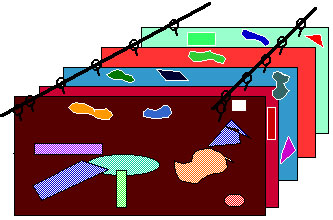
Put the
collage in the archive
Return the signs to the universe



